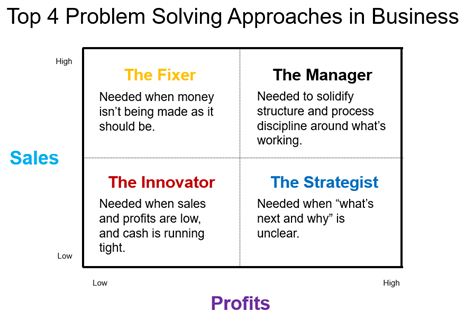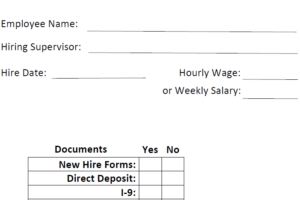
Synopsis
Successful small businesses are led by disciplined and skilled individuals who recognize what needs to be done when and then get it done as required. They will put on various hats depending on where their business needs them most through four primary problem-solving approaches. Each hat represents a different approach to solve the problems keeping them from making the money they should.
In business, there are four fundamental approaches to solving problems. They involve the skills of fixers, innovators, managers, and strategists. The most effective leaders use a combination of these four styles for solving problems, while the ineffective ones have a favored go-to mode they’re comfortable with. As a result, they over-rely on their preferred approach to problem-solving rather than flexing their problem-solving approaches as required to solve their most pressing problem.
At any one time in business, there is always one “number one” problem to solve. What that #1 problem is most often depends on how well sales and profits are performing relative to each other. For example, high sales and low profits present a different set of problems than low sales and high profits. The first scenario indicates a conversion cost problem that has a business overspending to generate their sales, whereas the second scenario is not sustainable. Eventually, businesses with high profits and declining sales will fall into low profits and low sales unless things are going forward are done differently to generate more new sales at higher profits.
Below are the four most common approaches to solving problems in business:

The Fixer—needed when money isn’t being made as it should be.
Fixers are drawn to chaos. They can go into “stuck” situations and cut through the mess, to solve the presenting problem keeping them from realizing their goals. The downside of overplaying the fixers style is fixers are quick to move on to another crisis using their preferred problem-solving approaches. I.e., they have a hammer looking for nails to pound when a screwdriver is needed. The most typical problems they solve is high sales and low profits.
The Innovator—needed when sales and profits are low, and cash is running tight.
Innovators are needed when a company is stagnant or at risk of becoming obsolete. They can look at where they are at with a fresh perspective to reinvent how something has been done or to invent something from scratch. A business needing innovation, needs an owner who is willing to lead the change for doing things differently. The problem with innovators is they are too easily distracted chasing after new “shiny objects” rather than build on what’s working well. The most typical problem they solve is when things need to be done quickly differently to improve sales and profits.
The Manager—needed to solidify structure and process discipline around what’s working.
Managers ensure the business fundamentals, process, and structure are in place to sustain their ability to make more money through ever-increasing sales and profits. They are constantly confirming the business foundation is firm and that no cracks exist in it that will compromise the results of their actions. The most typical problem they solve is fine-tuning the actions that are working for continuous sales and profit improvement.
The Strategist—needed when “what’s next and why” is unclear.
Strategists are skilled at seeing the big picture, the whole playing field, what’s coming around the corner, so they are ahead of potential sales problems that will lead to profit problems. They bring people together around the purpose of the business and their model for making money. The strategist is skilled at converting their vision for why their business exists into executable plans. Ideally, the strategist is working on what’s next while profits are high to avoid problems needing solutions.
The best problem solvers frequently take stock of where they’re currently at, what’s working well, and where they are getting stuck relative to where they’re headed. This is how they identify which is the best problem-solving approach to close the gap between where they are now and where they want to be tomorrow, next week, month, and year.
Which problem-solving approach does your business need from you today?
If you aren’t clear on where your business needs the most improvement, and you aren’t sure how best to approach the problems holding you back from higher profits and more consistent cash flow, click here to receive a free review of your financial statements by a certified BusinessCPR™ Business Scientist to learn the most important area of improvement for your business with insights on how to apply the best problem-solving approach for that problem.
Where is your #1 area for improvement?
If you aren’t clear on where your business needs the most improvement, and you aren’t sure how best to approach the problems holding you back from higher profits and more consistent cash flow, click the link below to receive a free review of your financial statements by a certified BusinessCPR™ Business Scientist to learn the most important area of improvement for your business with insights on how to apply the best problem-solving approach for that problem.
FREE ASSESSMENT

